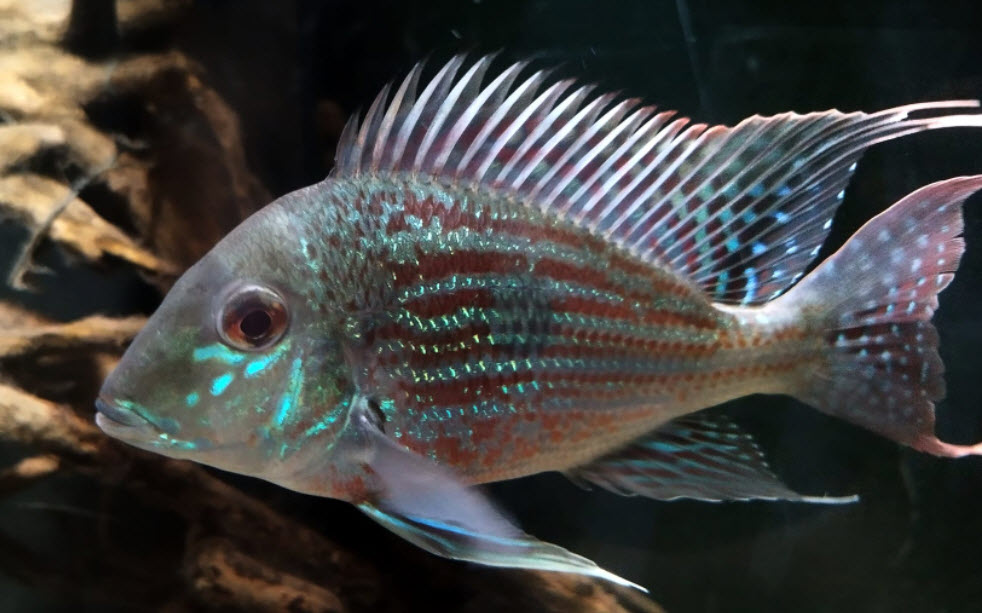Many, including myself, keep a close eye on Craig’s list for any cheap glass aquariums which come up for sale. These tanks often have a hard white deposit on the waterline. This white deposit is best removed with a pumice stone, stainless-steel pocketknife or steel wool. Read on if you want to become bored.

What is the White Deposit?
Old Aquariums often have a very stubborn white deposit on the waterline. When people come up on social media with the “How do I remove the white deposits?” the typical answers are:
- Bartender’s Friend (an acid compound)
- Lemon juice (an acid compound)
- Vinegar (an acid compound)
And all these answers will be incorrect the majority of the time due to what the “white stuff” really is.

In nature, in an area with limestone (a compound called “calcium carbonate”) under the surface, water percolating through a soil layer will pick up excess carbon dioxide from the decomposition of plants. This carbon dioxide filled water will dissolve a tiny bit of the limestone to form calcium bicarbonate, which is far more soluble than calcium carbonate. In a cavern, this dissolution will, throughout millions of years, form caverns.

The carbon dioxide/bicarbonate water will continue to drip into the cavern. When the cavern gets big enough, air will slowly start to ventilate the cavern. This air will remove some of the water from the drip. The calcium carbonate will then form a tiny deposit where the drip is. Over many thousands of years, these tiny deposits can give some very large stalactites and stalagmites which are made of pure limestone.
All the well meaning but ill-informed commentators on social media say that this limestone (calcium carbonate) is what the deposits are in aquariums. Any carbonate is attacked by acids, so Bartender’s friend, lemon juice, and vinegar are recommended to clean off the deposits. And other folks on social media will then come up and say “Bartender’s friend did not do anything. What did I do wrong?”. The answer is that the deposits are generally NOT pure calcium carbonate.

The white deposits in aquariums are typically formed by hard water interacting with bacteria. Bacteria grow very well on the glass at the waterline. These bacteria pull phosphates out of the water and incorporate them into their bodies. When the bacteria decompose, the phosphate reacts with the hard water to produce something called “hydroxyapatite”. Calcium and magnesium carbonates also precipitate out in this waterline region. And the bacteria add tough tenacious forms of protein to the mix.
The particles of calcium carbonate are coated with and cemented together by the hydroxyapatite and the protein strengthens the mix. The result can be very much like bone in its chemical and mechanical properties. And bone is NOT attacked by weak acids. Conversely the structure CAN also be much like limestone, weak, soft, and attacked by even weak acids. Which one it will be is virtually impossible to predict.
The longer the deposit has been in contact with the aquarium water typically the harder the deposit will be. Identical deposits form in toilet bowls in hard water areas.

But I can tell you that the white lines I’ve tried to remove from aquariums were the hydroxyapatite. Namely tougher than Hell. They laughed at acid, even concentrated hydrochloric. I once took an aquarium with white deposits and filled the tank with water. I very confidently added several gallons of vinegar and one gallon of concentrated hydrochloric acid (“pool acid”). I let the full tank sit for a week. After one week the white deposits were still there. Whoops! This forced me to rethink the whole scenario.
What all these means can be summarized by saying you probably cannot remove white deposits with Bartenders Friend, lemon juice, or vinegar.

Hardness Considerations
So what should one use to remove heavy deposits? Heavy deposits almost always require some sort of mechanical abrasion. Note that this ONLY applies to glass aquariums. Acrylic aquariums are virtually impossible to clean of white deposits.
The following Mohs hardness numbers are important here:

Glass is 5.5 Mohs hardness. Any mechanical media above 5.5 Mohs CAN damage the glass as it will be harder than the glass. And any media with a Mohs number lower than 5.5, in theory, will not scratch the glass. But note that hydroxyapatite is at 5.0 Mohs. In reality, most of the deposits will be somewhere between 2.5 and 5.0 Mohs as they will be a mix of apatite and carbonate.
What all this means is never use sandpaper on glass. The quartz grains will scrap the glass. Because of the way razorblades cut, it is normally pretty safe to use them on most deposits but on occasion, a razor blade can scratch glass.

Pumice stones, stainless steel pocketknives’ and steel wool are the preferred methods of removing most white deposits, being softer than glass but harder than most hydroxyapatite/carbonate/protein deposits. Note pumice stones are used with toilets and will remove the deposits with some elbow grease added in.

Crushed aluminum foil will work a small percentage of the time. It is always a good idea to start with the softest media (crushed aluminum foil) and move up the hardness scale. Only try a razorblade with really hard white deposits.


